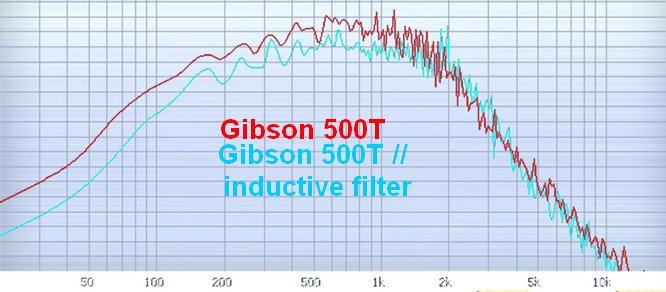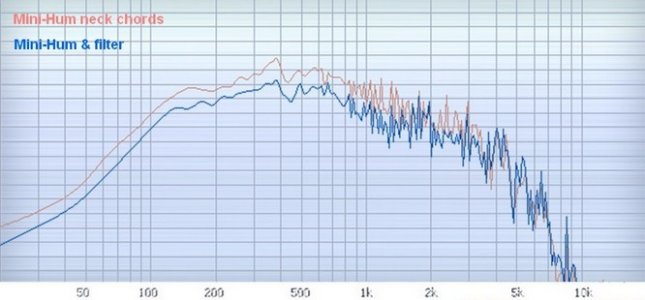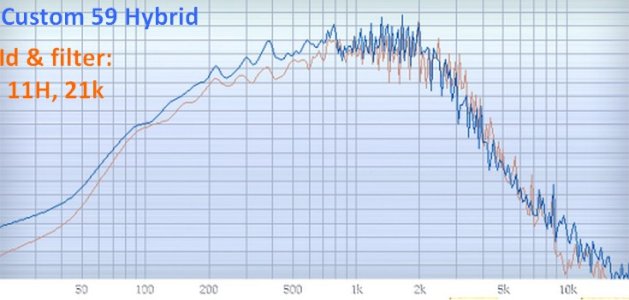freefrog
Well-known member
On dummy coils / inductors / chokes as tonal filters changing the voicing of pickups…
I’ve been asked to develop this question. I’ll keep my contribution relatively laconic by lack of free time. thx for your understanding.
SO, it’s possible to use some dummy coil(s) / inductor(s) / choke(s) in parallel with a pickup to change its response.
What does it do?
-It lowers the overall inductance and shifts up the resonant frequency of the pickup, making the sound brighter.
-it lowers the output level. This loss is more or less important, depending on the RESISTANCE of the inductive filter.
It’s a handy tool with powerful pickups but can be used with weaker ones too.
What can we use as parallel inductors?
I build my own filters myself but there’s “ready-made” solutions that I've used too when I wanted to work fast...
a)ghetto tech: just use an old HB without its baseplate and magnet(s) but still with its magnetic poles (since these iron cores increase the inductance of the coils)…
b)geeky tech: use the stronger coil of some mini audio transformer. They are sensitive to noise as a single coil would be but as their coils are very small, it’s not too noisy. It might produce just a wee bit of HF buzz… HINT - as they have a very low DCR, such transformers must be used in series with resistors or the output will be too low.
c)tinkerer option: find small cylindrical potted inductors and solder them in chain until you reach the desired inductance. Then add a series resistor of the desired value to this chain. The same thing can be done with Bill Lawrence Q filters, albeit it will be more expensive.
How to adapt such filters to the pickups used?
-With a powerful pickup, try a filter of the same DCR and inductance. Example: a HB measuring 16k and 8H in parallel with a 500T will give a "composite" pickup measuring roughly 8k and 4H, just like a P.A.F. clone. The filter won’t lower the inner stray capacitance of the 500T but it will still make it behave sonically like a weaker humbucker…
-With weaker transducers, increase the inductance and resistance of the filter : 6H and 36k in parallel with a 7.5k and 3.5H pickup will give 6.2k and 2.2H of overall DCR and inductance, just as if the pickup had been “unwound”. The effect will be less drastic than explained above but still noticeable and useable if the components involved have the proper specs…
Below are two examples of pickups played in chords direct to the board, alone then in parallel with their dedicated inductive filters: a bridge 500T, a neck mini-humbucker. Should illustrate how "parallel inductive filters" change the balance between fundamental notes and harmonics, for more tonal versatility…


FOOTNOTES.
-A series inductor is way less interesting but it can work to some extent.
-If you want the opposite effect, just put a low value capacitor in parallel with the pickup (1nF in parallel to make a SSL1 closer to a SSL5, for example: it won't have the power but it will mimic the voicing of the stronger PU).
-Add some capacitor(s) between dummy coil(s) and ground, and you'll have a VariTone but also something able to emulate acoustic guitars or the 2d/4th positions of a Strat: all depends here on the resistive / inductive / capacitive specs involved.
-Some lab gear is (sadly) necessary if we want the use of dummy coils to be something else than a shot in the dark. An inductance meter is a must have, for instance (also because the theoretical inductance of mini audio transformers is often not their real measured value)....
FWIW. HTH.
I’ve been asked to develop this question. I’ll keep my contribution relatively laconic by lack of free time. thx for your understanding.
SO, it’s possible to use some dummy coil(s) / inductor(s) / choke(s) in parallel with a pickup to change its response.
What does it do?
-It lowers the overall inductance and shifts up the resonant frequency of the pickup, making the sound brighter.
-it lowers the output level. This loss is more or less important, depending on the RESISTANCE of the inductive filter.
It’s a handy tool with powerful pickups but can be used with weaker ones too.
What can we use as parallel inductors?
I build my own filters myself but there’s “ready-made” solutions that I've used too when I wanted to work fast...
a)ghetto tech: just use an old HB without its baseplate and magnet(s) but still with its magnetic poles (since these iron cores increase the inductance of the coils)…
b)geeky tech: use the stronger coil of some mini audio transformer. They are sensitive to noise as a single coil would be but as their coils are very small, it’s not too noisy. It might produce just a wee bit of HF buzz… HINT - as they have a very low DCR, such transformers must be used in series with resistors or the output will be too low.
c)tinkerer option: find small cylindrical potted inductors and solder them in chain until you reach the desired inductance. Then add a series resistor of the desired value to this chain. The same thing can be done with Bill Lawrence Q filters, albeit it will be more expensive.
How to adapt such filters to the pickups used?
-With a powerful pickup, try a filter of the same DCR and inductance. Example: a HB measuring 16k and 8H in parallel with a 500T will give a "composite" pickup measuring roughly 8k and 4H, just like a P.A.F. clone. The filter won’t lower the inner stray capacitance of the 500T but it will still make it behave sonically like a weaker humbucker…
-With weaker transducers, increase the inductance and resistance of the filter : 6H and 36k in parallel with a 7.5k and 3.5H pickup will give 6.2k and 2.2H of overall DCR and inductance, just as if the pickup had been “unwound”. The effect will be less drastic than explained above but still noticeable and useable if the components involved have the proper specs…
Below are two examples of pickups played in chords direct to the board, alone then in parallel with their dedicated inductive filters: a bridge 500T, a neck mini-humbucker. Should illustrate how "parallel inductive filters" change the balance between fundamental notes and harmonics, for more tonal versatility…


FOOTNOTES.
-A series inductor is way less interesting but it can work to some extent.
-If you want the opposite effect, just put a low value capacitor in parallel with the pickup (1nF in parallel to make a SSL1 closer to a SSL5, for example: it won't have the power but it will mimic the voicing of the stronger PU).
-Add some capacitor(s) between dummy coil(s) and ground, and you'll have a VariTone but also something able to emulate acoustic guitars or the 2d/4th positions of a Strat: all depends here on the resistive / inductive / capacitive specs involved.
-Some lab gear is (sadly) necessary if we want the use of dummy coils to be something else than a shot in the dark. An inductance meter is a must have, for instance (also because the theoretical inductance of mini audio transformers is often not their real measured value)....
FWIW. HTH.


